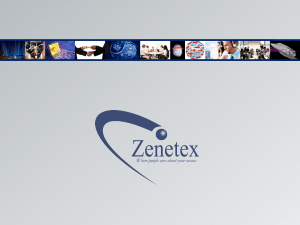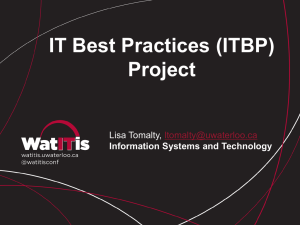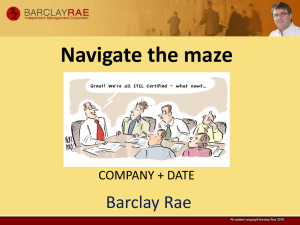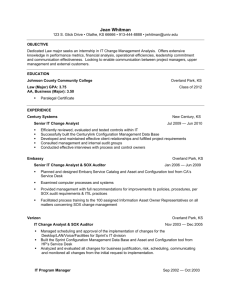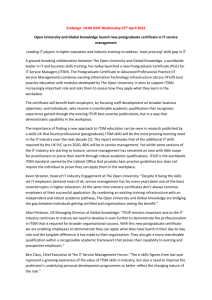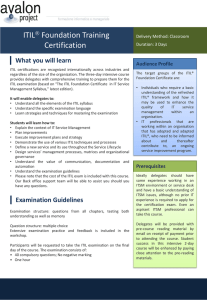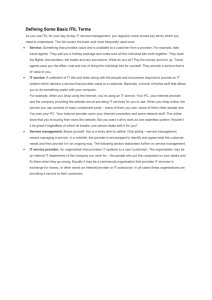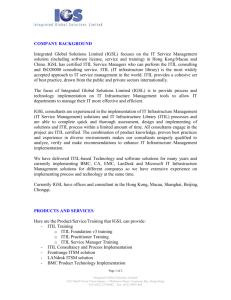Topics and Applied Theories in IT Service Management
advertisement
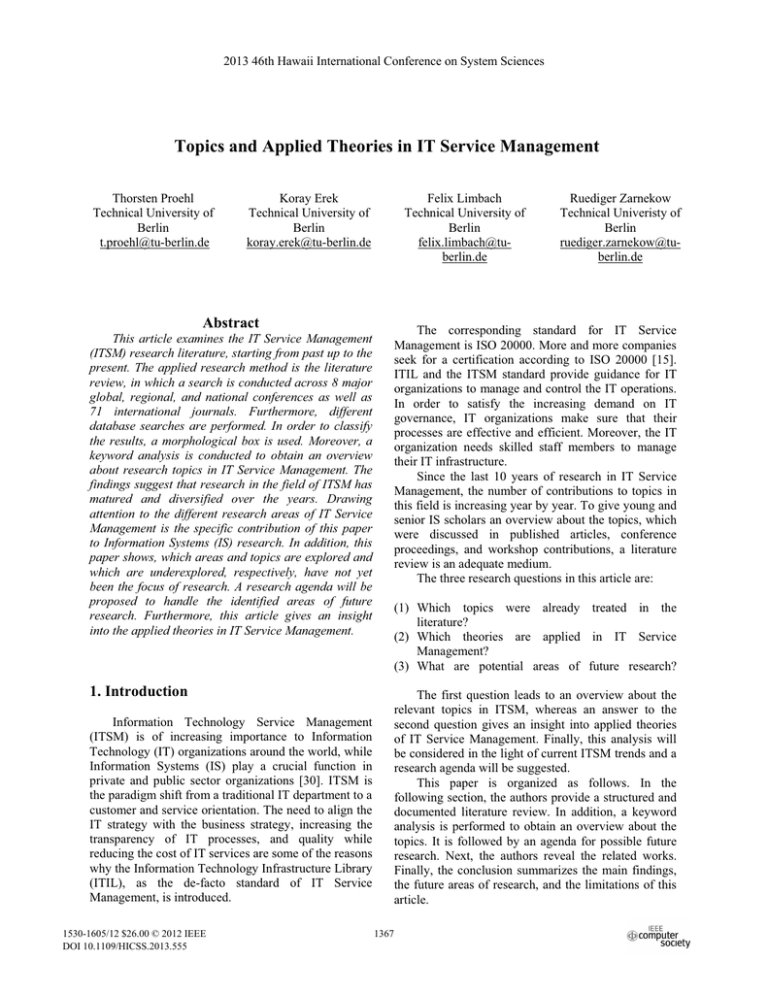
2013 46th Hawaii International Conference on System Sciences Topics and Applied Theories in IT Service Management Thorsten Proehl Technical University of Berlin t.proehl@tu-berlin.de Koray Erek Technical University of Berlin koray.erek@tu-berlin.de Felix Limbach Technical University of Berlin felix.limbach@tuberlin.de Abstract The corresponding standard for IT Service Management is ISO 20000. More and more companies seek for a certification according to ISO 20000 [15]. ITIL and the ITSM standard provide guidance for IT organizations to manage and control the IT operations. In order to satisfy the increasing demand on IT governance, IT organizations make sure that their processes are effective and efficient. Moreover, the IT organization needs skilled staff members to manage their IT infrastructure. Since the last 10 years of research in IT Service Management, the number of contributions to topics in this field is increasing year by year. To give young and senior IS scholars an overview about the topics, which were discussed in published articles, conference proceedings, and workshop contributions, a literature review is an adequate medium. The three research questions in this article are: This article examines the IT Service Management (ITSM) research literature, starting from past up to the present. The applied research method is the literature review, in which a search is conducted across 8 major global, regional, and national conferences as well as 71 international journals. Furthermore, different database searches are performed. In order to classify the results, a morphological box is used. Moreover, a keyword analysis is conducted to obtain an overview about research topics in IT Service Management. The findings suggest that research in the field of ITSM has matured and diversified over the years. Drawing attention to the different research areas of IT Service Management is the specific contribution of this paper to Information Systems (IS) research. In addition, this paper shows, which areas and topics are explored and which are underexplored, respectively, have not yet been the focus of research. A research agenda will be proposed to handle the identified areas of future research. Furthermore, this article gives an insight into the applied theories in IT Service Management. (1) Which topics were already treated in the literature? (2) Which theories are applied in IT Service Management? (3) What are potential areas of future research? 1. Introduction The first question leads to an overview about the relevant topics in ITSM, whereas an answer to the second question gives an insight into applied theories of IT Service Management. Finally, this analysis will be considered in the light of current ITSM trends and a research agenda will be suggested. This paper is organized as follows. In the following section, the authors provide a structured and documented literature review. In addition, a keyword analysis is performed to obtain an overview about the topics. It is followed by an agenda for possible future research. Next, the authors reveal the related works. Finally, the conclusion summarizes the main findings, the future areas of research, and the limitations of this article. Information Technology Service Management (ITSM) is of increasing importance to Information Technology (IT) organizations around the world, while Information Systems (IS) play a crucial function in private and public sector organizations [30]. ITSM is the paradigm shift from a traditional IT department to a customer and service orientation. The need to align the IT strategy with the business strategy, increasing the transparency of IT processes, and quality while reducing the cost of IT services are some of the reasons why the Information Technology Infrastructure Library (ITIL), as the de-facto standard of IT Service Management, is introduced. 1530-1605/12 $26.00 © 2012 IEEE DOI 10.1109/HICSS.2013.555 Ruediger Zarnekow Technical Univeristy of Berlin ruediger.zarnekow@tuberlin.de 1365 1367 Table 1. Taxonomy of literature reviews (following [12]) 2. Literature Review Baker explains a crafted literature review as the fundament for the elaboration of a new research project [28]. Moreover, vom Brocke et al. outline that literature reviews tend to identify unknown literature sources as well as “make[s] a vital contribution to the relevance and rigour of research” [44]. The term relevance means that a pure reproduction of a known knowledge base should be avoided [28], however, an effective, accurate, and precise use of this knowledge base is necessary [22]. In order to document the literature search process and to obtain comprehensible and resilient results, vom Brocke et al. propose a five-step literature review framework (Figure 1) [44]. This framework was used to conduct the subsequent literature review on IT Service Management and yields the structure of this article. The definition of the review scope is thus the first of five mandatory steps. It is followed by a conceptualization of the topic and, as a third step, the literature search itself. This search is conducted according to Webster and Watson [46]. The fourth step comprises the analysis and synthesis of the literature. In order to classify the identified articles, a morphological box is used. Finally, a research agenda is derived from the findings. Definition of Review Scope Conceptualization of Topic Literature Search Literature Analysis & Synthesis Characteristic 1 Focus 2 Goal 3 Perspective 4 Coverage 5 Organization 6 Audience Categories Research Outcomes Research Methods Integration Identification of Central Issues Criticism Neutral Representation Exhaustive Historical Specialized Scholars Practices or Applications Theories Espousal of Position Exhaustive with Selective Citation Representative Conceptual General Scholars Central or Pivotal Methodological Practitioners General Public 2.2. Conceptualization of the Topic After defining the review scope, vom Brocke et al. suggest that a review needs to continue with a conceptualization of the topic [44]. Figure 2 shows the appreciable issues around the term IT Service Management (on a meta level). These terms serve as a basis for the different stages of the literature search process. However, the terms Service Science, Service Management, and Service Engineering are not considered as they lead away from the actual goal of the literature review. These terms are used to classify IT Service Management per se. HP IT Service Management Research Agenda Frameworks IBM Tivoli Unified Process IT Infrastructure Library Service Science Microsoft Operations Framework Figure 1. Framework for literature reviewing (following [44]) Service Management Service Engineering IT Service Management BS 15000 2.1. Definition of the Review Scope Standards In their article, vom Brocke et al. recommend to draw a taxonomy for the purpose of defining the specific scope of the literature review [44]. Cooper presents a taxonomy that comprises six characteristics [12], which can further be described by one or multiple categories (Table 1). Vom Brocke et al. emphasize that some characteristics, such as perspective and coverage, are mutually exclusive, while the other characteristics can be independently combined [44]. In the table below, categories gray highlighted show the focus areas of this literature review. ISO 20000 Staff training Figure 2. Conceptualization of IT Service Management Vom Brocke et al. rephrase Torraco in their “broad conception of what is known about the topic” [42, 44]. Hence, a common understanding of basic terms and definitions is mandatory in every field of research and for every research intention. Zorn and Campbell emphasize this statement [49]. Table 2 provides definitions of the key terms in this research field to satisfy this demand. 1368 1366 Table 2. Terms and definitions according to the glossary of the ITIL 2011 edition [1] Term Definition ISO/IEC 20000 IT Service IT Service (ITSM) Management IT Infrastructure (ITIL) Service Management Conference Search Library Journal Search Database Search Backward Search Forward Search Figure 3. Five steps literature search process An international standard for IT Service Management. A service provided by an IT service provider. An IT service is made up of a combination of information technology, people and processes. A customerfacing IT service directly supports the business processes of one or more customers and its service level targets should be defined in a service level agreement. Other IT services, called supporting services, are not directly used by the business but are required by the service provider to deliver customerfacing services. See also core service; enabling service; enhancing service; service; service package. The implementation and management of quality IT services that meet the needs of the business. IT Service Management is performed by IT service providers through an appropriate mix of people, process and information technology. A set of best-practice publications for IT Service Management. Owned by the Cabinet Office (part of HM Government), ITIL gives guidance on the provision of quality IT services and the processes, functions and other capabilities needed to support them. The ITIL framework is based on a service lifecycle and consists of five lifecycle stages (service strategy, service design, service transition, service operation and continual service improvement), each of which has its own supporting publication. There is also a set of complementary ITIL publications providing guidance specific to industry sectors, organization types, operating models and technology architectures. A set of specialized organizational capabilities for providing value to customers in the form of services. Table 3 shows the keywords which were derived from Figure 2 and used within the five steps of the literature search process. Table 3. Used terms for the search Keyword Abbreviation IT Service Management ITSM IT Infrastructure Library ITIL ISO/IEC 20000 ITSM Frameworks Similar spellings respectively meanings IT Servicemanagement, Information Technology Service Management ITIL V2, ITIL V3, ITIL-based, Service Strategy, Service Design, Service Transition, Service Operation, Continual Service Improvement, Information Technology Infrastructure Library ISO 20000, BS 15000 Microsoft Operations Framework, MOF, IBM Tivoli Unified Process, ITUP, HP IT Service Management, HP ITSM All steps were performed by two researchers, so that the results are valid and resilient, and no important article or contribution was overlooked. To achieve a high degree of reproducibility, a comprehensive documentation of the procedure and the results is necessary. Starting with the conference search, the authors consider eight major global, regional, and national conferences. The AIS Electronic Library (AISeL) was used to browse through the AIS conferences (AMCIS and ICIS), the AIS chapters (ACIS), the AIS affiliated conferences (ECIS, MCIS, and PACIS), and other AIS conferences (WI). Due to the number of ITSM-related proceedings, the HICSS was also examined. In order to find relevant articles, the authors manually considered title, abstract, and keywords of the proceedings for the whole available period. Table 3 was used as a decision criterion, and so it was determined whether the respective article is within the scope or not. Table 4 shows the number of results for each conference. The Forrester report about IT Service Management support tools shows that ITIL V2 as well as ITIL V3 have a significant market share among IT Service Management frameworks [23]. Therefore, the authors used the definitions of the key terms from the glossary of the ITIL 2011 edition [1]. Moreover, Conger et al. defined IT Service Management as focusing on “defining, managing, and delivering IT services to support business goals and customer needs, usually in IT Operations” [11]. Pollard et al., on the other hand, rephrased IT Service Management as “a strategy that focuses on defining, managing and delivering IT services and addresses the need for IT to become more customer-focused by offering information systems under contract to customers and managing IT performance as a service” [33]. In addition, IT Service Management can be viewed as a subset of Service Science [19]. IT Service Management is a customer-oriented understanding of the IT organization, as opposed to the long-established functional orientation. The IT Infrastructure Library provides a best practice framework for these new challenges. The goal of ITIL is the creation of value for customers and organizations through the provision of IT services which are aligned with business strategy and meet business requirements [9]. Table 4. Considered conferences Abbreviation / Name ACIS: Australasian Conference on Information Systems AMCIS: Americas Conference on Information Systems ECIS: European Conference on Information Systems HICSS: Hawaii International Conference on System Sciences ICIS: International Conference on Information Systems MCIS: Mediterranean Conference on Information Systems PACIS: Pacific Asia Conference on Information Systems WI: International Conference on Wirtschaftsinformatik Period 2001-2011 1997-2011 2000-2011 1995-2012 1994-2011 2006-2011 1993-2011 1999-2011 13 34 12 13 5 0 8 10 95 Following the conference search, a journal search was performed on the basis of AIS MIS Journal Ranking. Especially journals with Average Rank Points (ARP) less than or equal to 30 were analyzed, therefore, 71 journals were considered. The ARP for each journal are calculated as the average of 9 rankings. Similar to the previous stage of the search process, the authors manually considered title, abstract and keywords of the journal articles for the whole available period. Table 3 was used as a decision criterion, and so it was determined whether the 2.3. Literature Search In order to perform an exhaustive literature search, a five-step process according to Webster and Watson was designed and realized (Figure 3) [46]. The idea behind this approach is to obtain all articles and contributions in the field of IT Service Management; consequently, it builds an enormous body of knowledge for the authors and other IS scholars. 1369 1367 A total of 13 articles were available but not accessible: 10 articles from Science Direct (7 articles for the keyword “IT Service Management”, 1 article for the keyword “Information Technology Service Management”, 1 article for the keyword “IT Infrastructure Library”, and 1 article for the keyword “Service Transition”), plus three articles from IEEEXplore (all for the keyword “IT Service Management”). The penultimate step of the search process is the backward search - to be more accurate - the backward reference search, where the authors went through the references of the collected articles yielded from the journal search. The references of the references etc. are out of this literature review scope, because that would inflate the results gathered by the literature search. Finally, a forward reference search was performed on the journal search results. Figure 4 outlines the whole literature search process and shows the number of results for the backward as well as for the forward search. respective article is within the scope or not. Table 5 presents the number of results for each journal as well as the Average Rank Points. The brackets imply that some articles are available but not accessible. In order to reduce the size of the table, only journals with at least one result are shown. Table 5. Considered journals Abbreviation / Name ARP ISR: Information Systems Research CACM: Communications of the ACM JMIS: Journal of Management Information Systems IEEETrans: IEEE Transactions (on Network and Service Management) I&M: Information & Management CAIS: Communications of the Association for Information Systems JComp: Journal on Computing OS: Organization Science CMR: California Management Review JCIS: Journal of Computer Information Systems IBMSJ: IBM Systems Journal WIRT: Wirtschaftsinformatik BISE: Business & Information Systems Engineering ISM: Information Systems Management 2.67 2.75 4.86 1 1 3 (+1) 3 0 (+1) 4 1 1 1 2 3 (+1) 5 2 8 (+6) 35 (+9) 8.75 11.89 14.00 16.00 18.00 21.00 24.86 26.00 28.00 28.00 29.00 Afterwards, a database search was performed in EBSCOhost (Business Source Complete), ProQuest (ASSIA, ERIC, PAIS, and PILOTS), Emerald, Science Direct (Journals: Business, Management and Accounting, Computer Science, and Decision Sciences), AISeL, and IEEEXplore using the known keywords (Table 3). The database search involves title, text, and abstract. The number of results and the number of new articles were recorded (Table 6). The list of results was sorted by relevance and only the top 150 results were investigated. For the purpose of reducing table size, only keywords which generated at least one result are shown. The table shows not only the results for each keyword, but also the number of results (new ones), that were not found in previous steps and in the overall result list. = 95 4 2 0 1 1 0 0 0 3302 24 40 5 1 2 0 1 59 45 0 5 0 0 0 0 43 22 1 7 7 0 0 0 621 441 8 86 43 0 1 1 IT Infrastructure Library ITIL ITIL V2 ITIL V3 ITIL-based Service Strategy Service Design Service Transition Service Operation Continual Service Improvement Information Technology Infrastructure Library 452 2391 20 93 57 2254 3310 140 2990 35 368 3 5 0 0 0 0 0 0 0 1 0 0 6 0 0 0 32 118 7 37 0 4 0 1 0 0 0 0 0 0 0 0 0 63 49 0 2 0 602 1016 24 557 5 23 2 0 0 0 0 0 0 0 0 0 0 24 255 2 7 7 729 944 43 1981 2 24 0 0 0 0 0 0 0 0 0 0 0 18 41 0 0 1 4 22 0 0 0 8 0 0 0 0 0 0 1 0 0 0 0 300 1340 18 141 51 635 2279 223 2550 83 212 2 2 0 2 1 2 0 0 0 4 2 35 68 38 0 0 0 0 0 0 0 0 0 5 7 2 0 0 0 4 6 4 0 0 0 5 4 1 0 0 0 110 58 23 0 0 0 9 6 3559 2 321 0 3 0 1 0 0 0 0 0 0 0 9 0 0 0 0 0 0 0 0 0 0 0 2 0 89 0 0 0 3 0 0 0 0 0 0 0 2 0 683 0 8 0 0 0 0 0 0 0 0 0 4 0 0 0 0 0 0 0 0 0 0 0 0 0 23 29 4727 7 70 10 9 0 1 0 0 0 0 0 2 6 104 (+13) 0 8 EBSCOhost ProQuest Emerald Science Direct Forward Search The backward search is performed on the basis of the journal search results. The forward search is performed on the basis of the journal search results. = 35 = 104 = 21 =0 = 255 Figure 4. Overview about the number of results obtained by each step IEEEXplore 15 2 0 0 27 Based on AIS MIS Journal Ranking, for journals with Average Rank Points <= 30. Backward Search IEEEXplore In this step, the gathered literature was analyzed and synthesized to answer the research questions and deduce a research agenda. Webster and Watson show that a successful literature review informs the reader about the lessons learned and founded patterns [46]. Using a morphological box, a classification of the collected literature is achieved (Table 7). This box is developed according to the literature taxonomy of Cooper [12], which was already introduced in the first step of the literature review framework (Table 1). The characteristics focus, goal, and audience are adopted from Cooper [12], whereas the other two characteristics type of literature and research method are necessary adjustments according to Alavi and Carlson [27]. The authors counted articles applying to the categories in order to classify the literature. It is not in the scope of this article to list all possible characteristics and categories; only appropriate ones, New ones Results AISeL New ones Results New ones Results Science Direct Emerald New ones Results New ones Results ProQuest EBSCOhost New ones Results 991 374 9 77 ITSM Frameworks Microsoft Operations Framework MOF IBM Tivoli Unified Process ITUP HP IT Service Management HP ITSM Sum Total sum AIS related and affiliated conferences + HICSS. Database Search 2.4. Literature Analysis and Synthesis IT Service Management ITSM IT Servicemanagement Information Technology Service Management ISO/IEC 20000 ISO 20000 BS 15000 Journal Search AISeL Table 6. Considered databases and corresponding results Keyword Conference Search 61 1370 1368 applied approach which is particularly suitable for the ITSM research. The first step is a short, welldocumented literature review, used to obtain an overview of the existing literature. It is followed by an initial investigation, where the scholars use surveys, interviews, case studies, or action research to identify the “real-life” problem. The third step then is the development of a concept, framework, model, or theory. Finally, an evaluation is necessary to test the artifact from the previous step. which were found during the literature review, are shown. The listed categories were not mutually exclusive. The research method others comprises Workshops, Action Research, Narrative inquiry, and Prototypes. Table 7. Morphological box for literature analysis Characteristic Categories Research Outcomes (192 / 47%) Focus Theories (61 / 15%) Integration (126 / 48%) Goal Practices or Applications (159 / 39%) Identification of Central Issues (136 / 52%) Audience Specialized Scholars (224 / 48%) General Scholars (84 / 18%) Practitioners (161 / 34%) Type of Literature Journal Articles (75 / 29%) Conference Proceedings (147 / 58%) Workshops (33 / 13%) Research Method Literature Review (49 / 14%) Case Study (82 / 23%) Survey (37 / 10%) Interviews (27 / 7%) Conceptual (141 / 39%) Literature Review Others (25 / 7%) Concept Framework Model Theory Evaluation via via Survey Interview Case Study Action Research Case Study Action Research Figure 6. Recommended research approach Table 7 shows the results for the different characteristics. It is interesting to observe, that the development of theories is underrepresented in the field of IT Service Management. Around 15% of the articles have developed or used common theories; Cater-Steel et al., for example, applied the institutional theory in their paper [7]. Furthermore, a keyword analysis shows that IS researcher in this field have applied theories such as the actor network theory, the contingency theory, the interdisciplinary theory, the organizational learning, and the stratified systems theory. The majority of the articles is about research outcomes. Thus, the target audience of these articles is mainly specialized scholars. And as IS scholars in this field are dealing with the development of concepts, frameworks, and models, the lion's share (39%) of these articles are conceptual articles. The findings about the development of theories, concepts, frameworks, and models were also noticed by Shahsavarani and Ji [37]. Some researchers used case studies or action research to validate their concepts. Further on, in only 14% of the papers literature review is used as a research method. Where it is used, the focus is often only on a specific topic and the literature review is rarely well-documented. The authors often found a 2-step process (Figure 5). The difficulty of this approach is that the concept, framework, or model comes from an idea instead from practice. Concept Framework Model Initial Investigation Table 7 exhibits that 10% of the researchers performed surveys. Marrone and Kolbe conducted an empirical study on benefits, challenges, and processes of ITIL [30]. This is the only comprehensive study about these ITIL topics. Its limitations are the geographical focus on the USA and the UK, while at the same time mainly large organizations took part of the study. Therefore, future research might cover further countries and SMEs (small and medium-sized enterprises). At the end, a comparison with Marrone and Kolbe [30] is suggested. During literature analysis, the authors noticed that the analysis of critical success factors (CSFs) was limited to countries like Australia, Germany, Norway, Switzerland, and the USA [24, 32, 40]. However, there are many other countries like India or China that might need to be examined for critical success factors as well. Ghayekhloo et al. offer aspects from Iran [20], whereas Kanapathy and Khan studied Malaysia [26]. This is important because local conditions might exert influence on critical success factors. Ghayekhloo et al. show some local constraints such as “low speed of internet, filtering, huge amount of holidays on, one couldn't get expected service” [20]. Moreover, they recognized that a good localization of software tools is important. This raises the question whether there are constraints in other countries, too. Another point is the influence of company size on the critical success factors. Marrone and Kolbe mentioned that their study solely focuses on large organizations alone [30]. An additional examination of SMEs might therefore reveal further barriers or obstacles, which are not found in large organizations. Another finding is that the considered articles show no comprehensive cost-benefit analysis for the implementation of ITIL projects. Deutscher and Felden noticed that process improvements cause costs [13]. Case Study Figure 5. Observed research approach For the development of more reliable concepts, frameworks, models, and theories, the authors recommend the following research approach that is based on their observations. Figure 6 illustrates an 1371 1369 instrument for performance measurement and management of IT organizations respectively [29]. Gacenga et al. specify a research gap in ITSM performance measurement by “A review of the existing empirical literature reveals a gap in research in ITSM performance measurement” [18]. A new topic for the IT Service Management appears on the horizon. The ITSM is often understood as the change from a functional to a service- or customer-orientated IT Organization. The next change might be the turn towards business orientation. The Business Service Management (BSM) is a process centric view through the use of business process metrics [21]. Moreover, a keyword analysis was performed in order to obtain an advanced overview of the topics in IT Service Management. By counting the keywords of each contribution, the analysis shows a frequency distribution. Table 8 shows only the grouped keywords and the corresponding number of results. The whole keyword table would exceed the page limitation of this paper. Some contributions are not tagged with keywords; therefore, the overall number of keywords is lower than expected. Hence, Deutscher and Felden presented a concept to identify improvement opportunities using IT Service Management frameworks [14]. Cater-Steel et al. explained that the implementation of a process improvement framework needs to be case dependent [6]. Winniford et al. presented the barriers to IT Service Management adoption in organizations [48]. According to their findings, around 47% stated that ITSM costs too much (multiple answers were possible). Therefore, the authors recommend contributions which tackle the topics cost-benefit analysis for ITSM projects and cost-benefit analysis for ITSM process improvements. Moreover, the analysis offers that there are no contributions about cloud computing in respect of IT Service Management. But, cloud computing can be viewed as a new sourcing strategy of IT Service Management. However, IT outsourcing together with IT Service Management was already discussed in the literature [34, 36, 43, 45]. In addition, the use of ITIL to improve the data center operations has not been extensively studied. Furthermore, the analysis shows that a lot of articles are dealing with ITIL and the corresponding processes like incident management and service level management [2, 31, 35, 39, 43]. Thereby, the authors noticed that there is effectively no research about an ITIL implementation approach, which based on finished projects and best practices. In this context, the investigation of differences between SMEs, large enterprise, and the public sector are interesting. The authors observed during the literature analysis that the integration of ITIL respectively ITSM into Information Systems curriculum is a topic for IS scholars. Three ways of integration, lessons learned, and teaching cases were described [3–5, 8, 10, 25, 47]. Only a few countries like Australia, Germany, the UK, and the USA are covered by this research. Lessons learned and teachings cases from other countries might bring added value. Due to the circumstance that the literature search was driven by the specific terms (Table 3), a subset of the results rather belongs to IT Governance because of the articles’ focus on Control Objectives for Information and related Technology (COBIT). In these articles, IT Service Management is only mentioned in passing or is used as comparison (ITIL/COBIT mapping), respectively as supplement to COBIT (integrated IT management framework). Furthermore, analysis of the articles reveals that the demarcation between IT Operation with ITIL as a common ITSM framework and IT Governance with COBIT is not explicit or sharp, but rather a fluent passage. Finally, there are explicit IT Governance tools, such as the IT Balanced Scorecard (IT BSC), which are used as an Table 8. Keywords analysis results Grouped keyword ITSM Framework ITSM Governance Service Miscellaneous Method ITSM Process Standard Modeling Service Science SOA Curriculum Alignment Knowledge Software Strategy Target area Theory Value Performance Number of keywords 141 99 56 51 48 47 37 26 26 25 18 16 16 15 15 14 13 12 12 11 Grouped keyword Maturity Quality Sourcing Customer Country Ontology Information Organization CSF SLA Other Frameworks Review of decisions Customization Modularization Risk Reuse Compliance Benefits Vendor Sustainability Number of keywords 11 10 10 10 7 7 6 5 5 5 4 4 4 4 3 2 2 2 2 2 3. Research Agenda Starting from the preceding literature analysis and synthesis, a research agenda is “comprised of sharper and more insightful questions for future research” [44]. Thereby, the following agenda aims to answer the third research question (What are potential areas of future research?) by showing how research might continue. The authors propose the following research steps, which do not claim to be exhaustive (Figure 7): 1372 1370 IT Service Management and Data Centers Empirical study on benefits, challenges, and processes for small and medium-sized enterprises (SMEs) Investigation of CSFs for ITIL implementations ITIL implementation approach based on best practices Investigation of CSFs for ITIL implementations IT Service Management Research IT Service Management and Cloud Computing Further investigation of critical success factors for ITIL implementation in small and medium-sized enterprises and other countries like India or China. What are the main CSFs? Which barriers arise in the context of SMEs? Which are the local constraints? [20, 40] ITIL implementation approach based on best practices Investigation of the ITIL implementation in small and medium-sized as well as large enterprises, and the public sector. Starting with a review of finished projects, interviews and case studies might be suitable to identify: How was ITIL implemented? Who was involved? How did the implementation project start? Are there organizational- and sectional-specific differences (private vs. public sector)? Development of an ITIL implementation approach, which shows how to implement ITIL in the context of small and medium-sized as well as large enterprises, and in the public sector. Validation of this implementation approach via case studies. Is this approach helpful and does this lead to a successful ITIL implementation? In addition, the literature analysis and synthesis part of this paper show further areas for potential research, like the IS curriculum. Because of the lack of research, however, the authors propose to focus first on the five topics above. [38] Figure 7. Research agenda IT Service Management and Cloud Computing The influence of cloud computing on IT Service Management, especially ITIL, might be studied using case studies. What is the effect of cloud computing as a new sourcing strategy on IT Service Management? What are the changes and challenges in general and which processes are affected? Are there differences between the supplier and customer side? [41] In the context of community and private clouds, how can IT Service Management support the sourcing strategy of data centers? Which processes are necessary for the datacenter to implement in order to be ready for cloud challenges like data privacy and security? [16] 4. Related Works IT Service Management and Data Centers The authors found only one comparable contribution during the literature search. A literature review by Shahsavarani and Ji [37] investigated the research in the field of IT Service Management. The three main findings are: “1) there is generally a lack of theoretically driven researches; 2) the field is still developing with a growing number of published papers dealing with the development of concepts, constructs, models, methods and implementations for theory development; 3) ITSM performance issues, justifications, and IT Infrastructure Library topics are among the most popular topics of research” [37]. These outcomes are confirmed by the present work, although this paper performed another search approach. The approach in this paper is more extensive and delivers more relevant articles. Moreover, this paper shows other findings based on the considered articles. These two articles complement each other and offer a holistic view on the research field. IT Service Management in the context of data centers. How can ITIL be used to improve data center specific operations? Which ITIL processes, concepts, or ideas provide added value for data centers? How can a Configuration Management Database (CMDB) be implemented and maintained to address data center needs? How can a data center use Service Portfolio Management to develop new services? [17] Empirical study on benefits, challenges, and processes for small and medium-sized enterprises (SMEs) Continuation or realization of a survey with an increased consideration of smaller IT organizations and countries besides the USA and the UK according to the limitations of Marrone and Kolbe [30]. Moreover, the disadvantages and obstacles should be recorded as part of the survey. 1373 1371 5. Conclusion This article analyzed the body of knowledge in the field of IT Service Management. Therefore, the authors have conducted a structured literature review using a proven framework. A total of 255 articles on IT Service Management were analyzed. The authors were able to answer the first two research questions (Which topics were already treated in the literature? Which theories are applied in IT Service Management?) by searching, analyzing, and classifying the body of knowledge in IT Service Management and the third research question (What are potential areas of future research?) by suggesting a research agenda. Thus, the authors observed that a huge amount of articles handle issues around the ITIL framework, were developing concepts, but only few articles have used or developed theories. Moreover, an extended research approach was presented. The research agenda shows five topics for future research, whereby the topics of cloud computing and data centers relating to IT Service Management as well as critical success factors for SMEs and the development of an ITIL implementation approach were proposed for further research. Nevertheless, a critical appraisal is always mandatory. Although this article is based on a rigorous and comprehensible literature search, the authors cannot guarantee for its completeness. The authors know two major improvements which will be considered in the next literature review respectively for further research. On the one hand, two other types of backward search might be considered: backward authors search and previously used keywords. Moreover, the level of the backward references search might be extended. On the other hand, a forward author search might be conducted to reveal more contributions. In order to obtain more results from forward as well as backward search, the researcher can omit the limitation to conduct both kinds of search only on the journal search results. One additional limitation is the missing access to content found in Science Direct. If this review was to be extended, it could be done by updating the conducted searches with results published after April 2012. 6. References [1] APMG, http://www.itilofficialsite.com/InternationalActivities/ITILGlossaries_ 2.aspx, accessed 6-4-2012. [2] Arora, A. and W. Bandara, "IT Service Desk Process Improvement - A Narrative Style Case Study", PACIS 2006 Proceedings(78), 2006. [3] Bandara, W., J. Cornes, and M. Rosemann, "Business Process Redesign in Information Technology Incident Management: A Teaching case", ACIS 2005 Proceedings(22), 2005. [4] Bentley, J., "Integration of ITIL into the IS Curriculum", ACIS 2006 Proceedings(51), 2006. [5] Cater-Steel, A. and M. Toleman, "The Role of Universities in IT Service Management Education", PACIS 2007 Proceedings(49), 2007. [6] Cater-Steel, A., W.-G. Tan, and M. Toleman, "Challenge of adopting multiple process improvement frameworks", ECIS 2006 Proceedings(177), 2006. [7] Cater-Steel, A., W.-G. Tan, and M. Toleman, "Using Institutionalism as a Lens to Examine ITIL Adoption and Diffusion", ACIS 2009 Proceedings(73), 2009. [8] Cater-Steel, A., R. Zarnekow, and J. Wulf, "IT Service Management In The Academic Curriculum: Comparing An Australian And German Experience", PACIS 2011 Proceedings(33), 2011. [9] Conger, S., "Information Technology Service Management and Opportunities for Information Systems Curricula", International Journal of Information Systems in the Service Sector, 1(2), 2009, pp. 58–68. [10] Conger, S., A. Urbaczewski, and R. Venkataraman, "IT Services Management in the Curriculum: Challenges, Realizations, and Lessons Learned", AMCIS 2010 Proceedings(465), 2010. [11] Conger, S., M. Winniford, and L. Erickson-Harris, "Service Management in Operations", AMCIS 2008 Proceedings(362), 2008. [12] Cooper, H.M., "Organizing Knowledge Syntheses: A Taxonomy of Literature Reviews", Knowledge in Society, 1(1), 1988. [13] Deutscher, J.-H. and C. Felden, "Model Concept to Determine the Optimal Maturity of IT Service Management Processes", Proceedings of the 8th IEEE/ACIS International Conference on Computer and Information Science, 2009, pp. 543–548. [14] Deutscher, J.-H. and C. Felden, "20P. Concept for Identification of Improvement Opportunities Provided by ITSM Frameworks to Address Specific Needs of Organizations", CONF-IRM 2010 Proceedings(44), 2010. [15] Disterer, G., "ISO 20000 for IT", Business & Information Systems Engineering, 1(6), 2009, pp. 463– 467. [16] Drucker, P., "Self Service, the Cloud and ITSM… One Big Happy Family?", At yor Service (itSMF), 2(1), 2012. [17] Fry, M., "5 questions about ITSM and cloud computing", Whitepaper, 2010. [18] Gacenga, F., A. Cater-Steel, W.-G. Tan, and M. Toleman, "IT Service Management: Towards a Contingency Theory of Performance Measurement", ICIS 2011 Proceedings(5), 2011. [19] Galup, S.D., R. Dattero, J.J. Quan, and S. Conger, "An overview of IT service management", Communications of the ACM, 52(5), 2009, pp. 124–127. [20] Ghayekhloo, S., M. Sedighi, R. Nassiri, G.L. Shabgahi, and H.K. Tirkolaei, "Pathology of Organizations Currently Implementing ITIL in Developing Countries", ICCEE 2009 Proceedings, 2, 2009, pp. 7–10. 1374 1372 [21] Gyory, A., W. Brenner, and F. Uebernickel, "Finding the Right Balanced Scorecard for Business-Driven IT Management: A Literature Review", HICSS 2012 Proceedings, 2012, pp. 5023–5032. [22] Hevner, A.R., S.T. March, J. Park, and S. Ram, "Design Science in Information Systems Research", MIS Quarterly, 28(1), 2004, pp. 75–105. [23] Hubbert, E., "Market Overview: IT Service Management Support Tools", Forrester Report, 2010. [24] Iden, J. and L. Langeland, "Setting the Stage for a Successful ITIL Adoption: A Delphi Study of IT Experts in the Norwegian Armed Forces", Information Systems Management, 27(2), 2010, pp. 103–112. [25] Jarman, R., "Progress in Introducing ITIL into an Information Systems Curriculum", AMCIS 2011 Proceedings(396), 2011. [26] Kanapathy, K. and K.I. Khan, "Assessing the Relationship between ITIL Implementation Progress and Firm Size: Evidence from Malaysia", International Journal of Business and Management, 7(2), 2012, pp. 194–199. [27] M. Alavi, P.C., "A Review of MIS Research and Disciplinary Development", Journal of Management Information Systems, 8(4), 1992, pp. 45–62. [28] M.J. Baker, "Writing a Literature Review", The Marketing Review(1), 2000, pp. 219–247. [29] Marcos, A.F., J.I. Rouyet, and A. Bosch, "An IT Balance Scorecard Design under Service Management Philosophy", HICSS 2012 Proceedings, 2012, pp. 4972– 4981. [30] Marrone, M. and L.M. Kolbe, "Impact of IT Service Management Frameworks on the IT Organization", Business & Information Systems Engineering, 3(1), 2011, pp. 5–18. [31] Muhren, W.J., G. van Den Eede, and B. van de Walle, "Organizational Learning for the Incident Management Process: Lessons from High Reliability Organizations", ECIS 2007 Proceedings(65), 2007. [32] Pollard, C. and A. Cater-Steel, "Justifications, Strategies, and Critical Success Factors in Successful ITIL Implementations in U.S. and Australian Companies: An Exploratory Study", Information Systems Management, 26(2), 2009, pp. 164–175. [33] Pollard, C.E., D. Gupta, and J.W. Satzinger, "Teaching Systems Development: A Compelling Case for Integrating the SDLC with the ITSM Lifecycle", Information Systems Management, 27(2), 2010, pp. 113–122. [34] Ricardo, B. and M. Toleman, "Outsourcing IT: Views from the Vendor's Side", ACIS 2003 Proceedings(38), 2003. [35] Sauve, J., R. Santos, R. Reboucas, A. Moura, and C. Bartolini, "Change Priority Determination in IT Service Management Based on Risk Exposure", IEEE Transactions on Network and Service Management, 5(3), 2008, pp. 178–187. [36] Schermann, M., T. Böhmann, and H. Krcmar, "Integration of IT services: Towards a pattern-based approach for eliciting service integration requirements", AMCIS 2006 Proceedings(312), 2006. [37] Shahsavarani, N. and S. Ji, "Research in Information Technology Service Management (ITSM): Theoretical Foundation and Research Topic Perspectives", CONFIRM 2011 Proceedings(30), 2011. [38] Spremic, M., Z. Zmirak, and K. Kraljevic, "IT and Business Process Performance Management: Case Study of ITIL Implementation in Finance Service Industry", International Conference on Information Technology Interfaces, 2008. [39] Tamm, G. and R. Zarnekow, "Umsetzung eines ITILkonformen IT-Service-Support auf der Grundlage von Web-Services", Wirtschaftsinformatik Proceedings 2005(34), 2005. [40] Tan, W.-G., A. Cater-Steel, and M. Toleman, "Implementing IT service management: a case study focusing on critical success factors", The Journal of Computer Information Systems, 50(2), 2009, pp. 1–12. [41] Tomoda, K., http://www.fujitsu.com/downloads/MAG/vol464/paper03.pdf, accessed 9-11-2012. [42] Torraco, R.J., "Writing Integrative Literature Reviews: Guidelines and Examples", Human Resource Development Review, 4(3), 2005, pp. 356–367. [43] Unterharnscheidt, P. and A. Kieninger, "Service Level Management - Challenges and their Relevance from the Customers' Point of View", AMCIS 2010 Proceedings(540), 2010. [44] Vom Brocke, J., A. Simons, B. Niehaves, K. Reimer, R. Plattfaut, and A. Cleven, "Reconstructing the giant: On the importance of rigour in documenting the literature search process", ECIS 2009 Proceedings(161), 2009. [45] Wan, S.H. and Y.-H. Chan, "Improving service management in outsourced IT operations", Journal of Facilities Management, 5(3), 2007, pp. 188–204. [46] Webster, J. and R.T. Watson, "Analyzing the Past to Prepare for the Future: Writing a literature Review", MIS Quarterly, 26(2), 2002, pp. 13–23. [47] Whittleston, S., "IT Service Management Practices in Education; a new breed of IT Professional Concept Paper", UK Academy for Information Systems Conference Proceedings 2009(51), 2009. [48] Winniford, M., S. Conger, and L. Erickson-Harris, "Confusion in the Ranks: IT Service Management Practice and Terminology", Information Systems Management, 26(2), 2009, pp. 153–163. [49] Zorn, T., "Improving The Writing Of Literature Reviews Through A Literature Integration Exercise", Business Communication Quarterly, 69(2), 2006, pp. 172–183. 1375 1373

